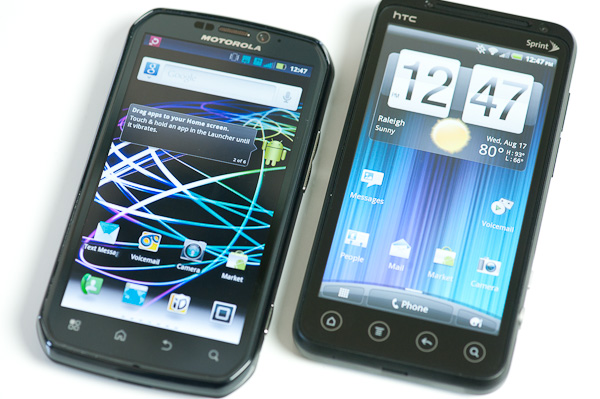
Sprint Nextel has introduced two stunning Android smartphones; Motorola Photon 4G and HTC EVO 3D. Despite having the obvious difference of 3D capability, Photon 4G and EVO 3D have been largely compared by reviewers. Indeed, it is apt because both devices run on a single carrier and a single OS platform. Both smartphones have a set of cutting-edge features to compete each other. While EVO 3D is the first glasses-free 3D smartphone in the market, its rival Photon 4G is light in weight, with enterprise-friendly features and Sprint’s WiMAX high-speed Internet. This article makes a comparison between the two breathtaking Android smartphones on Sprint.
Comparison Attributes
Elaborate investigating into the features and failures of HTC EVO 3D and Motorola Photon 4G, key aspects of the devices are compared below to find out which is the winner in each category.
Processor
Processor is a key factor of a handheld device. It determines the speed and performance of any computing device. Motorola has slotted in a 1 GHz dual core NVIDIA Tegra 2 processor in the Photon 4G smartphone. Meanwhile, EVO 3D features 1.2 GHz dual core Qualcomm Snapdragon processor.
Winner: HTC EVO 3D with its faster and better processor.
Camera
HTC EVO 3D has two 5 megapixel cameras in the rear panel for 3D capturing. Motorola Photon 4G has a one 8 megapixel camera. The former is a perfect 3D device. You can capture both 3D stills and videos using EVO 3D. It is certainly an innovative feature, and it becomes more incredible as it is the first glasses-free 3D phone. But the challenge is that there are only a few people who admire watching 3D content yet. Though 3D technology is live, people have not widely started enjoying 3D images and videos. In terms of 2D image clarity, the Photon 4G is the better phone of the two, because of its 8 megapixel camera. EVO 3D only has a 5 megapixel camera for 2D capturing.
Winner: When it comes 3D, HTC EVO 3D is the undeniable winner. As for 2D imaging, Motorola Photon 4G gains the score.
User Interface
HTC Sense UI adds a touch of perfection to its newest smartphone, EVO 3D. Sense UI is an extremely good-looking interface especially in terms of 3D transitions. Motorola’s GhostBlur is not as attractive on Photon 4G. But the Motorola smartphone also features Sprint’s SprintID software besides GhostBlur to add into the completeness.
Winner: HTC Sense UI is largely acclaimed for its superb interface. With HTC EVO 3D also, the HTC interface works smoothly.
Dimensions and weight
Size and weight of a smartphone have large significance. Users prefer devices that are light and slim over those that are heavy and bulky. Photon 4G is about 127 mm long, 67 mm wide and 12.2 mm thick, with a weight of 158 grams. The EVO 3D is 126 mm long, 65 mm wide and 12.1 mm thick with a weight of 170 grams.
Winner: Over the parameters of dimension and weight, both phones are well matched. Both phones have almost identical dimensions. Photon 4G has a slight advantage over EVO 3D as it is marginally lighter.
Power consumption
Photon 4G has an edge in this aspect, with 10 hours of talk time. EVO 3D has a talk time of 7 hours and 30 minutes. EVO 3D packs in an Li-ion battery of 1730 mAh and Photon a Li-ion battery 1700mAh.
Winner: Photon 4G convincingly wins over HTC EVO in this category with its longer battery life and comparatively lower power consumption.
Other capabilities
EVO is equipped with a set of great features such as WiFi 802.11b/ g /n, advanced Bluetooth v3.0 (with A2DP and EDR), DLNA, GPS, GPRS/ EDGE, stereo FM, 3G (HDDPA and HSUPA) and so on. Photon 4G is also powered by most of these features. Wi-Fi 802.11b/g/n, Bluetooth v2.1 with EDR, HDMI out, Sprint 4G WiMAX radio and GPS with A-GPS are the Motorola smartphone’s capabilities.
Winner: Most of these features are present in both HTC EVO 3D and Motorola Photon 4G. However, the former outdoes the latter with its advanced Bluetooth v3.0. Motorola Photon features only Bluetooth v 2.1.
The verdict:
Even with all these differences, HTC EVO 3D and Motorola Photon 4G have some similarities in several key aspects. The devices have 4.3-inch displays with the same resolution of 960 x 540 pixels. The smartphones are identical in RAM capacity, front facing cameras, geo-tagging and face detection and several other features. To top it all, both EVO 3D and Photon 4G run on the same firmware, Android v 2.3 (Gingerbread), the latest version of the Android OS. In short, these devices have become two leading smartphones on Sprint Nextel. While 3D features may induce customers towards HTC EVO 3D, the WiMAX high-speed Internet and webtop application features will pull customers towards the Motorola smartphone.




